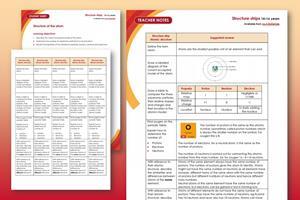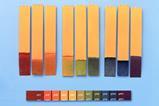Support learners to retrieve information on the model of the atom and subatomic particles
This resource is part of our support for literacy in science teaching, designed to embed literacy into your curriculum and develop learners’ skills in reading, writing and talking about science and their understanding of scientific language.
-

Download this
Download the structure strips, which are printed five to a page, support learners to find or retrieve information and write independently.
Find model answers in the teacher guidance.
View and download more Structure strips
Learning objectives
- Describe the current accepted model of the atom.
- Determine the number of subatomic particles in a neutral atom.
- Recall the properties of each subatomic particle.
Introduction
Atomic structure is one of the most important topics in chemistry. Lots of other topics depend on understanding the structure of the atom and the properties of the subatomic particles.
How to use structure strips
Structure strips are a type of scaffolding you can use to support learners to retrieve information independently. Use them to take an overview at the start of the topic, to activate prior knowledge, or to summarise learning at the end of a teaching topic. For more ideas on how to use structure strips with your learners, see 5 ways to use structure strips effectively
Structure strips have sections containing prompts which are sized to suggest the amount that learners must write. Learners glue the strips into the margin of an exercise book and write their answers next to the sections, in full sentences. When learners have finished using the structure strip, they should have an A4 page set of notes and examples.
The strips are printed five to a page and will need to be trimmed to size. Find them on the second page of the student sheet.
Scaffolding
To further support learners to answer the questions you can include a list of keywords or add prompts to the structure strip.
As learners grow in confidence, they may be able to answer the question without the structure strip or attempt the question first and then use the structure strip to improve or self-assess their answer.
Keywords
atom, matter, proton, electron, neutron, nucleus, orbit, atomic number, mass number, ion, isotope
Metacognition
This activity supports learners to develop their metacognitive skills in three key areas.
- Planning: the strips provide scaffolding to plan the written response. Learners will decide where to gather information from (textbooks, own notes, revision websites). Ask learners: is the source of information you are using reliable?
- Monitoring: learners are prompted by the questions in the structure strip and can check their answer against the prompts. Ask learners: have you covered all of the questions in the space provided? Do you need to change anything to complete the task?
- Evaluation: learners can self-assess or ask a peer to check their work against the answers. Ask learners: did you achieve what you meant to achieve? What might you do differently next time?
Follow-up question
Explain, with reference to subatomic particles, why an atom of potassium has an overall neutral charge.
Answers
Suggested answers for the structure strip activity are given in the downloadable teacher notes (MS Word | PDF).
Answer to follow-up question
Potassium has the atomic number 19. It has 19 positively charged protons and 19 negatively charged electrons. Therefore, the charges of the subatomic particles cancel out and overall charge on the atom is neutral.
Downloads
Structure of the atom structure strip student sheet
Handout | PDF, Size 0.13 mbStructure of the atom structure strip teacher notes and answers
Handout | PDF, Size 0.2 mbStructure of the atom structure strip student sheet
Editable handout | Word, Size 0.43 mbStructure of the atom structure strip teacher notes and answers
Editable handout | Word, Size 0.46 mb
















































No comments yet